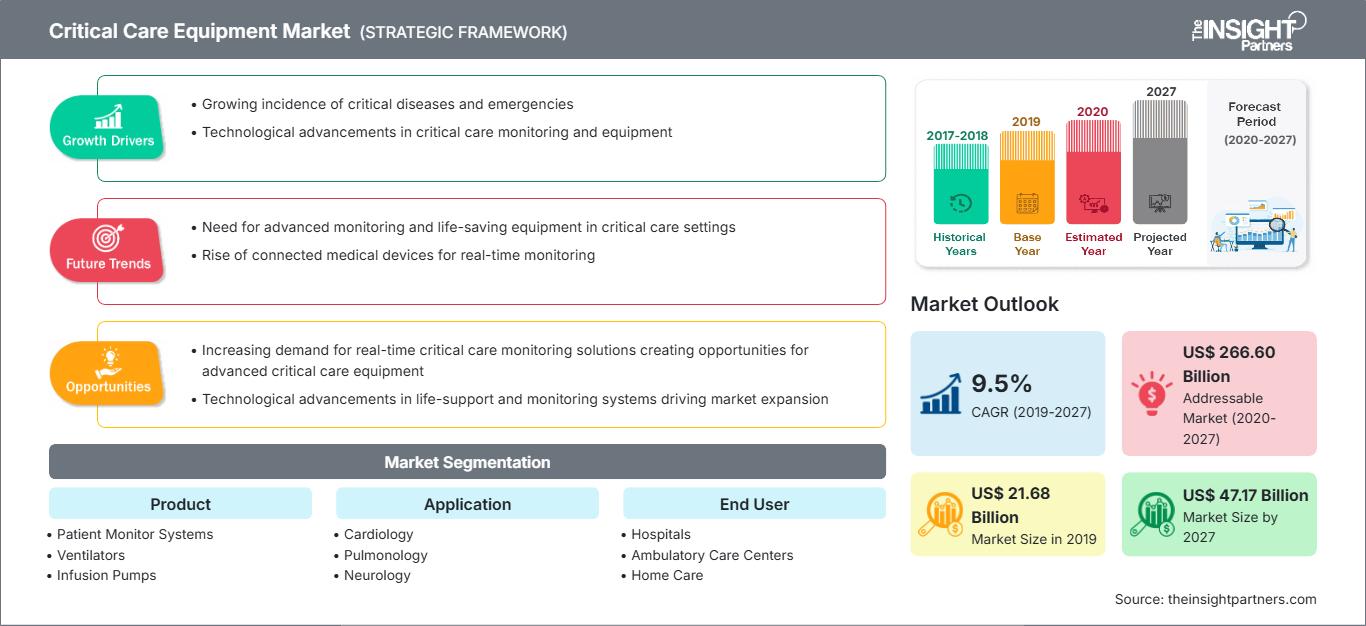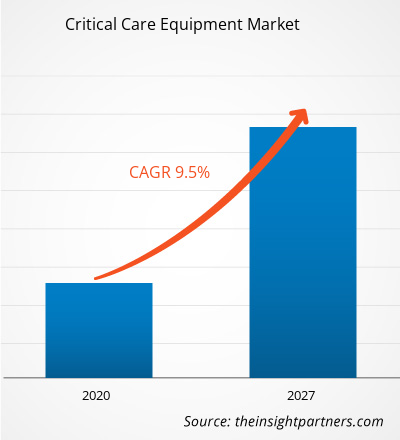Der Markt für Intensivpflegegeräte wurde 2019 auf 21.682,65 Millionen US-Dollar geschätzt und soll bis 2027 47.171,42 Millionen US-Dollar erreichen; für den Zeitraum 2020–2027 wird ein durchschnittliches jährliches Wachstum von 9,5 % erwartet.
Ein Intensivbett ist so ausgestattet und besetzt, dass es eine intensive Pflege ermöglicht und mechanische Beatmung sowie invasive Überwachung ermöglicht. Laut dem National Center for Biotechnology Information war im Mai 2020, als sich Kanada auf dem Höhepunkt des COVID-19-Ausbruchs befand, der Bedarf an Intensivbetten deutlich höher als im Vorjahr, selbst bei 40 % Selbstisolation. Die Anzahl der vorhandenen Intensivbetten in den einzelnen Regionen lag zwischen 0,63 und 1,85 pro 10.000 Personen. Bei einer geschätzten aktuellen Auslastung von 80 % würden die freien Intensivbetten für COVID-19-Patienten in der Region zwischen 0,13 und 0,37 pro 10.000 Personen schwanken.
Patienten mit der Infektion verbringen durchschnittlich 15 Tage auf der Intensivstation. Laut der Europäischen Gesellschaft für Anästhesiologie steigt die Zahl der Intensivbetten in Italien weiter an. In der Lombardei gab es vor der Ausbreitung des Coronavirus 140 private und 500 öffentliche Intensivbetten, bis Ende März 2020 waren es über 900.
Passen Sie diesen Bericht Ihren Anforderungen an
Sie erhalten kostenlos Anpassungen an jedem Bericht, einschließlich Teilen dieses Berichts oder einer Analyse auf Länderebene, eines Excel-Datenpakets sowie tolle Angebote und Rabatte für Start-ups und Universitäten.
Markt für Intensivpflegegeräte: Strategische Einblicke

- Holen Sie sich die wichtigsten Markttrends aus diesem Bericht.Dieses KOSTENLOSE Beispiel umfasst Datenanalysen, die von Markttrends bis hin zu Schätzungen und Prognosen reichen.
Markteinblicke: Steigende Zahl von Intensivbetten in Ländern mit hoher COVID-19-Prävalenz treibt Marktwachstum an
Sie erhalten kostenlos Anpassungen an jedem Bericht, einschließlich Teilen dieses Berichts oder einer Analyse auf Länderebene, eines Excel-Datenpakets sowie tolle Angebote und Rabatte für Start-ups und Universitäten.
Markt für Intensivpflegegeräte: Strategische Einblicke

- Holen Sie sich die wichtigsten Markttrends aus diesem Bericht.Dieses KOSTENLOSE Beispiel umfasst Datenanalysen, die von Markttrends bis hin zu Schätzungen und Prognosen reichen.
COVID-19 wurde am 11. März 2020 von der Weltgesundheitsorganisation zur globalen Pandemie erklärt. Diese neuartige Krankheit ist durch eine geringere Anzahl von Ersterkrankungen gekennzeichnet, gefolgt von einer explosionsartigen Ausbreitung der Infektionen in verschiedenen Ländern. Trotz der Lockdowns zur Eindämmung der COVID-19-Ausbreitung sind die Gesundheitssysteme in verschiedenen Ländern mit der Nachfrage nach Geräten wie Intensivbetten und unterstützender Ausrüstung zur Behandlung schwerer Krankheitsfälle überfordert.
Produkteinblicke
Produktbezogen hatte das Segment Patientenüberwachungssysteme 2019 den größten Marktanteil und wird voraussichtlich auch im Prognosezeitraum ein führender Anteilseigner bleiben. Allerdings wird für das Segment Beatmungsgeräte im Prognosezeitraum eine höhere durchschnittliche jährliche Wachstumsrate (CAGR) erwartet.
Anwendungseinblicke
Basierend auf der Anwendung ist der globale Markt für Intensivpflegegeräte in Kardiologie, Pulmonologie, Neurologie, Orthopädie und andere segmentiert. Das Segment Kardiologie hatte 2019 den größten Marktanteil und das Segment Pulmonologie wird im Prognosezeitraum voraussichtlich die höchste durchschnittliche jährliche Wachstumsrate (CAGR) verzeichnen. Die kardiovaskuläre Intensivpflege ist die systemische Behandlung von Patienten mit schweren Herz-Kreislauf-Erkrankungen (CVD), einschließlich Gefäßerkrankungen und Herzkrankheiten. CVD gehört zu den häufigsten Todesursachen weltweit. So starben der Weltgesundheitsorganisation zufolge im Jahr 2016 schätzungsweise 17,9 Millionen Menschen an CVDs, was 31 % aller Todesfälle weltweit entspricht. Und den Centers for Diseases Control and Prevention zufolge sterben jedes Jahr etwa 655.000 Amerikaner an Herzkrankheiten. Um Todesfälle durch Herz-Kreislauf-Erkrankungen zu verhindern, stehen in Allgemeinkrankenhäusern Intensivstationen für Patienten mit schweren Herz-Kreislauf-Erkrankungen, die sogenannten kardiovaskulären Intensivstationen (CICU), zur Verfügung. Die technologischen Entwicklungen in der klinischen Kardiologie, wie intrakoronare interventionelle Verfahren und Geräte sowie invasives hämodynamisches Monitoring, stellen die wichtigsten Entwicklungen in der Intensivmedizin bei Herz-Kreislauf-Erkrankungen dar. Infolgedessen steigt die Zahl der Patienten mit schweren Herz-Kreislauf-Erkrankungen, die auf die CICU eingeliefert werden, jährlich an. Die Patienten auf der CICU leiden an zahlreichen Komplikationen wie Atemversagen und Nierenversagen. Daher ist geschultes medizinisches Personal für die systemische Intensivpflege erforderlich.
Kooperationen und Technologiepartnerschaften der Akteure auf dem Markt für Intensivpflegegeräte zur Überbrückung der Angebots-Nachfrage-Lücke werden voraussichtlich im Prognosezeitraum eine bedeutende Rolle für das Marktwachstum spielen.
IntensivpflegegeräteRegionale Einblicke in den Markt für Intensivpflegegeräte
Die Analysten von The Insight Partners haben die regionalen Trends und Faktoren, die den Markt für Intensivpflegegeräte im Prognosezeitraum beeinflussen, ausführlich erläutert. In diesem Abschnitt werden auch die Marktsegmente und die geografische Lage in Nordamerika, Europa, dem asiatisch-pazifischen Raum, dem Nahen Osten und Afrika sowie Süd- und Mittelamerika erörtert.
Umfang des Marktberichts über Intensivpflegegeräte
| Berichtsattribut | Einzelheiten |
|---|---|
| Marktgröße in 2019 | US$ 21.68 Billion |
| Marktgröße nach 2027 | US$ 47.17 Billion |
| Globale CAGR (2019 - 2027) | 9.5% |
| Historische Daten | 2017-2018 |
| Prognosezeitraum | 2020-2027 |
| Abgedeckte Segmente |
By Produkt
|
| Abgedeckte Regionen und Länder | Nordamerika
|
| Marktführer und wichtige Unternehmensprofile |
|
Dichte der Marktteilnehmer für Intensivpflegegeräte: Auswirkungen auf die Geschäftsdynamik verstehen
Der Markt für Intensivpflegegeräte wächst rasant. Dies wird durch die steigende Endverbrauchernachfrage aufgrund veränderter Verbraucherpräferenzen, technologischer Fortschritte und eines stärkeren Bewusstseins für die Produktvorteile vorangetrieben. Mit der steigenden Nachfrage erweitern Unternehmen ihr Angebot, entwickeln Innovationen, um den Bedürfnissen der Verbraucher gerecht zu werden, und nutzen neue Trends, was das Marktwachstum weiter ankurbelt.

- Holen Sie sich die Markt für Intensivpflegegeräte Übersicht der wichtigsten Akteure
- Patientenüberwachungssysteme
- Beatmungsgeräte
- Invasive Beatmungsgeräte
- Nicht-invasive Beatmungsgeräte
- Infusionspumpen
- Andere
Nach Anwendung
- Kardiologie
- Pulmonologie
- Neurologie
- Orthopädie
- Andere
Nach Endbenutzer
- Krankenhäuser
- Ambulante Pflegezentren
- Häusliche Pflege
- Andere
Nach Geografie
- Norden Amerika
- USA
- Kanada
- Mexiko
- Europa
- Frankreich
- Deutschland
- Italien
- Großbritannien
- Russland
- Asien-Pazifik (APAC)
- China
- Indien
- Süd Korea
- Japan
- Australien
- Naher Osten & Afrika (MEA)
- Südafrika
- Saudi-Arabien
- VAE
- Süd- und Mittelamerika (SCAM)
- Brasilien
- Argentinien
Unternehmensprofile
- General Electric Company
- Medtronic
- B. Braun Melsungen AG
- Baxter International Inc.
- Koninklijke Philips NV
- Getinge AB
- Hamilton Medical
- Löwenstein Medical UK Ltd.
- Drägerwerk AG & Co. KGaA
- Nihon Kohden Corporation
- Fisher & Paykel Healthcare Limited.
- Shenzhen Mindray Biomedical Electronics Co., Ltd.
- BPL
- Trivitron Healthcare
- SKANRAY TECHNOLOGIES PVT LTD
- Asahi Kasei Corporation
- Historische Analyse (2 Jahre), Basisjahr, Prognose (7 Jahre) mit CAGR
- PEST- und SWOT-Analyse
- Marktgröße Wert/Volumen – Global, Regional, Land
- Branchen- und Wettbewerbslandschaft
- Excel-Datensatz
Aktuelle Berichte
Verwandte Berichte
Erfahrungsberichte
Grund zum Kauf
- Fundierte Entscheidungsfindung
- Marktdynamik verstehen
- Wettbewerbsanalyse
- Kundeneinblicke
- Marktprognosen
- Risikominimierung
- Strategische Planung
- Investitionsbegründung
- Identifizierung neuer Märkte
- Verbesserung von Marketingstrategien
- Steigerung der Betriebseffizienz
- Anpassung an regulatorische Trends




















 Kostenlose Probe anfordern für - Markt für Intensivpflegegeräte
Kostenlose Probe anfordern für - Markt für Intensivpflegegeräte